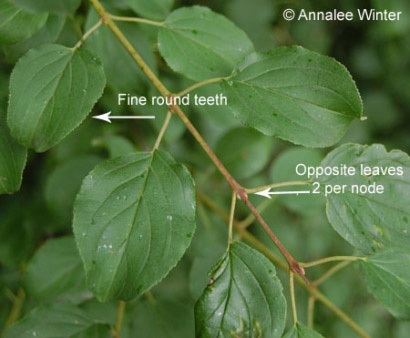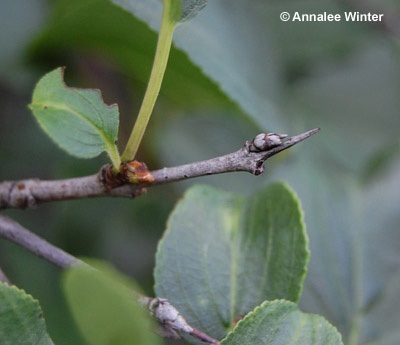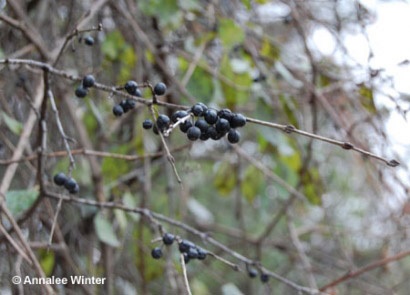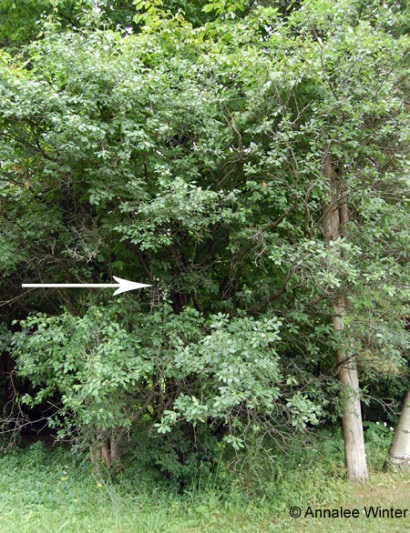Buckthorn species are wild hosts of spotted wing drosophila
Learn how to identify and control common buckthorn, a shrub that can be an alternate host for spotted wing drosophila.
The OMAFRA spotted wing drosophila (SWD) team learned a lot about SWD in 2012. Not only did the SWD spread rapidly throughout Ontario, but it was also found on a new wild host, common buckthorn (also known as European buckthorn) which is considered an invasive plant.
How to identify common buckthorn
- Buckthorn is usually the first shrub to leaf out in the spring and the last to drop its leaves late in the fall.
- It often grows 2 to 3 meters tall. Occasionally it reaches 6 meters, with a trunk up to 25 centimeters in diameter.
- It is distinguished by the sharp, thorn-tipped branches in contrast to the simple or compound thorns growing from the sides of branches in the Hawthorns.
- It has smooth, dark green leaves that are finely toothed, 2.5 to 6 centimeters long, with prominent forward-curved side veins, arranged in opposing pairs along the stem.
- It produces clusters of purplish-black berries along the stems and short twigs, and each berry usually has 4 hard seeds.
Impacts of common buckthorn
- The shrub can be an alternate host for spotted wing drosophila, a fruit fly that has become a widespread pest of soft-skinned fruits in Ontario.
- The shrub can host oat rust, a fungus that causes leaf and crown rust and affects the yield and quality of oats.
- The soybean aphid, an insect that damages soybean crops, can use buckthorn as a host plant to survive the winter.
- Because it can affect agricultural crops, common buckthorn is listed as a noxious weed under Ontario's Weed Control Act.
How to control common buckthorn
- A variety of mechanical control methods can be used to kill or remove buckthorn and other non-native plants.
- Cutting buckthorn shrubs has limited effectiveness because the plant resprouts.
- Girdling involves cutting the phloem (inner bark) but leaving the xylem (sapwood) intact. The roots nourish the top, but the top sends no nourishment back to the roots, which die out. Girdling is most effective in late spring or early summer (DNR WI). The shrub takes a year or two to die (Packard 1997).
- Seedlings or small plants may be hand pulled or removed with a hoe and will not resprout. Larger plants (1–6 cm in diameter) may be pulled out with heavy equipment. Disturbed soil will result from these techniques and should be tramped down to minimize exposing new buckthorn seeds (DNR WI). This technique may be most useful to control low densities.
- Land managers have had mixed results with the use of prescribed fire to control buckthorn species. Fire does not spread readily through buckthorn thickets and the buckthorn resprouts following burns, especially if moisture is available.
- Chemical control methods are best done during the fall or winter when most native plants are dormant yet buckthorns are still actively growing.
- Herbicide application to buckthorn seedlings has been shown to be effective. The best time to spray the foliage is very early in the spring, before native plants leaf out or later in the fall, after native plants drop their leaves. Common buckthorn is the first shrub to leaf out in the spring and the last plant to drop its leaves in the fall.
- Applying chemical (e.g. Garlon 4, glyphosate) to a recently cut stump is usually quite effective at killing buckthorns and minimizes the amount of chemical used. Shrubs can be cut using hand tools, chain saws or brush cutters and should be cut close to the ground. Chemical must be applied to freshly cut stumps to be effective. The chemical can be applied by paint brush or squirt bottle. Some chemicals must be applied to the remaining bark as well. Stump treatment can be carried out throughout the growing and dormant season. Dye should be added to mark the treated stumps.
- Basal bark treatment is a method that applies chemical on the bark of a standing tree/shrub. The chemical and its binding agent are absorbed through the bark into the plant, where it kills the living cambium.
- Frilling involves killing a standing tree by applying herbicide to a gash cut in the bark. The tree is gashed with an axe or chain saw and the herbicide is applied directly in the gash, killing the tree immediately. While this method requires a little more time than basal bark treatment, it is generally more effective as the chemical is applied directly to the growing parts of the standing trunk. This technique may be the most effective method to kill large buckthorn trees.
Table 1. Sample of chemical trials that successfully controlled buckthorn
From: Upper Grand River Conservation Authority factsheet (see references) (Note: Some trade name chemicals are not available in Canada.)
Method: Cut stump application
| Chemical | Timing |
|---|---|
| 20–25% glyphosate (diluted in water) | August or September |
| 10% glyphosate | August |
| 12.5% tricolopyr (form for oil dilution) | Summer or winter |
| Garlon 4 (1:3 of Garlon 4:oil/diluent) | - |
| 4% ester with diesel | - |
| AMS, aqueous concentrated | Year round |
| 25% Picloram + 75% 2,4-D | Summer |
Method: Frilling
| Chemical | Timing |
|---|---|
| 25% Picloram + 75% 2,4-D | Growing season |
| Garlon 4 | - |
Method: Basal bark application
| Chemical | Timing |
|---|---|
| 2-4% ester 2,4-D in diesel fuel | Early summer |
| 12.5% 2,4-D | - |
| 2.5-3% glyphosate | May to June |
| 10-20% Garlon in diesel fuel | Fall |
Method: Foliar
| Chemical | Timing |
|---|---|
| 4% fosamine | Actively growing |
| Glyphosate (e.g. Roundup) | Actively growing |
References
- Glossy buckthorn
- Buckthorn management
- Packard, Stephen and Cornelia Mutel. 1997. The Tallgrass Restoration Handbook for prairies, savannas and woodlands. Society for Ecological Restoration
- Upper Thames River Conservation Authority, London, Ontario
Other resources
- Ontario Invasive Plant Council
- Invasive Species: A Threat to Ontario's Biodiversity
- Weed identification guide for Ontario crops
- Invasive Species Centre
Updated: January 27, 2025
Published: June 29, 2022



